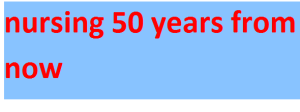nursing 50 years from now 2024-2025
nursing 50 years from now 2024-2025

The healthcare industry is always changing. This is arguably most evident in the field of nursing, where technological innovation, regulations imposed by the government, and medical advancements all come together to transform patient care.
The ability to lead others through these evolutionary processes is crucial for advanced practice nurses, such as those with a Master of Science in Nursing (MSN), especially as the health care industry prepares for a shortage of qualified nursing leaders. Understanding the likely future trends in nursing and their impact on patient care is the first step in staying current in this ever-evolving field.
What the Nursing Shortage Means for Nurses
The sector is likely to be impacted by a anticipated shortage of. Between 2020 and 2030, the U.S. Bureau of Labor Statistics (BLS) anticipates job growth of 9% for registered nurses (RNs) and 45% for nurse practitioners, nurse midwives, and nurse anesthetists. Both percentages are significantly higher than the 8 percent average growth that is anticipated for all occupations during the same time period.
There are several reasons for the nursing shortage:
- Population aging: According to the U.S. Census, the number of adults 65 and older in 2021 was 54 million, or about 16.5% of the population. The elderly have a greater need for medical attention, and this age group is only going to get bigger in the coming years.
Retired nurses: Many nurses plan to retire within the next few years because they are a part of the aging population. According to a report published in the American Journal of Nursing, nearly 5 million nurses worldwide will retire by 2030.
Faculty shortage in nursing: There aren’t enough nursing professors and instructors to meet the demand for training.
Burnout: Due to inadequate staffing, the COVID-19 pandemic has resulted in burnout among many nurses. A lot of nurses have decided to quit their jobs or retire early.
Nurses who have earned an advanced nursing degree can use their skills to become leaders in their field as it evolves to meet these challenges. Those who will embrace both current and future nursing trends and direct the course of care for patients of all ages are effective leaders.
Trends Affecting the Future of Nursing
- While the nursing profession is directly affected by the aging patient population and staffing shortages, other trends are also determining its future. In order to keep up with these trends, nurses need to have strong skills in areas like tech-driven knowledge that go beyond traditional nursing competencies.
Telehealth and Remote Nursing
Telephone-based remote patient care has been around for decades. However, the concept of telehealth now encompasses a wide range of multimedia channels beyond the phone, such as email, the internet, smartphone apps, and interactive videos. For instance, a patient’s symptoms and the nurse’s recommendation based on the patient’s past can be discussed in an email exchange.
- When the COVID-19 pandemic started in 2020, telehealth gained even more traction. Because of the virus’s rapid spread, many people were reluctant to visit the hospital. Nurses and other healthcare professionals were able to provide virtual care thanks to telehealth, reducing the risk of infection for both themselves and their patients.
- Patients and nurses alike find telehealth appealing because of its benefits during and after the pandemic. Nurses are able to work the hours of their choosing. They might, for instance, work in a private practice, a call center, or a disease management program. Because it eliminates the need for patients to travel to an office or hospital, telehealth may also be more convenient for them.
- Using clinical best practices, telehealth nurses assess the needs of patients, just like in a traditional nurse-patient relationship. In collaboration with patients, caregivers, and other medical personnel, they develop care plans. They look at the results and make better suggestions.
- There are many ways that nurses can care for patients from a distance. Asynchronous methods like video chats or phone calls are available for patients who wish to speak directly with their nurses or primary care providers. Asynchronous methods that nurses can use include sending and receiving messages, data, or images via communication platforms or portals.
- Another telehealth option for nurses, primary care physicians, physical therapists, and other medical professionals is remote patient monitoring. During a public health crisis, telehealth and remote nursing options benefit all patients in addition to patients who have difficulty visiting their nurses and care providers.
Click here for South African Nursing Colleges and Schools Application 2023-2024
RELATED LINKS
Nursing Online Application links